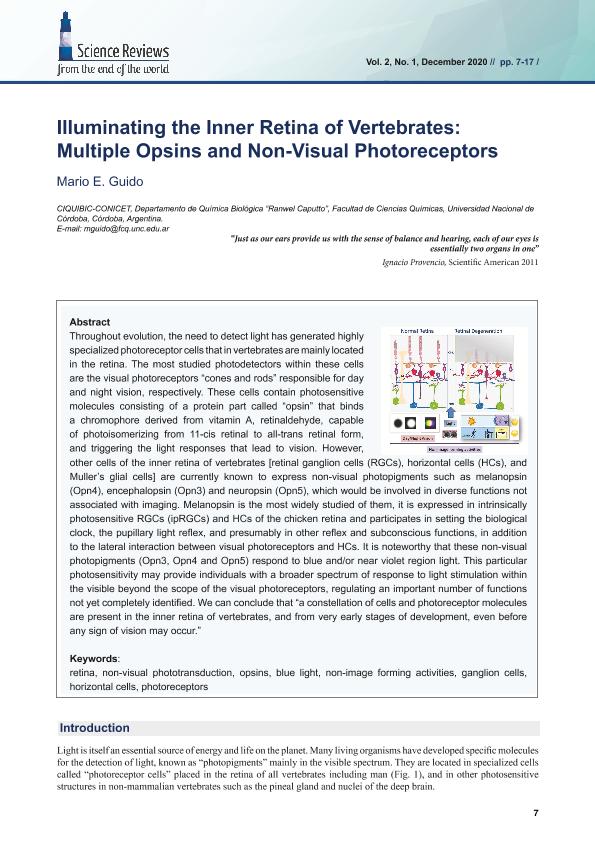Mostrar el registro sencillo del ítem
dc.contributor.author
Guido, Mario Eduardo

dc.date.available
2021-04-20T18:30:57Z
dc.date.issued
2020-12
dc.identifier.citation
Guido, Mario Eduardo; Illuminating the inner retina of vertebrates: Nonvisual photopigments with novel functions; Centro de Estudios sobre Ciencia, Desarrollo y Educacion Superior; Science review from the end of the world; 2; 1; 12-2020; 7-17
dc.identifier.issn
2683-9288
dc.identifier.uri
http://hdl.handle.net/11336/130526
dc.description.abstract
Throughout evolution, the need to detect light has generated highly specialized photoreceptor cells that in vertebrates are mainly located in the retina. The most studied photodetectors within these cells are the visual photoreceptors "cones and rods" responsible for day and night vision, respectively. These cells contain photosensitive molecules consisting of a protein part called ?opsin? that binds a chromophore derived from vitamin A, retinaldehyde, capable of photoisomerizing from 11-cis retinal to all-trans retinal form, and triggering the light responses that lead to vision. However, other cells of the inner retina of vertebrates (retinal ganglion cells (RGCs), horizontal cells (HCs), and Muller´s glial cells) are currently known to express non-visual photopigments such as melanopsin (Opn4), encephalopsin (Opn3 ) and neuropsin (Opn5), which would be involved in diverse functions not associated with imaging. Melanopsin is the most widely studied of them, it is expressed in intrinsically photosensitive RGCs (ipRGCs) and HCs of the chicken retina and participates in setting the biological clock, the pupillary light reflex, and presumably in other reflex and subconscious functions, in addition to the lateral interaction between visual photoreceptors and HCs. It is noteworthy that these non-visual photopigments (Opn3, Opn4 and Opn5) respond to blue and/or near violet region light. This particular photosensitivity may provide individuals with a broader spectrum of response to light stimulation within the visible beyond the scope of the visual photoreceptors, regulating an important number of functions not yet completely identified. We can conclude that a constellation of cells and photoreceptor molecules are present in the inner retina of vertebrates, and from very early stages of development, even before any sign of vision may occur.
dc.format
application/pdf
dc.language.iso
eng
dc.publisher
Centro de Estudios sobre Ciencia, Desarrollo y Educacion Superior
dc.rights
info:eu-repo/semantics/openAccess
dc.rights.uri
https://creativecommons.org/licenses/by-nc-sa/2.5/ar/
dc.subject
Opsinas no-visuales
dc.subject
Retina
dc.subject
Fotorreceptores
dc.subject
Luz azul
dc.subject.classification
Bioquímica y Biología Molecular

dc.subject.classification
Ciencias Biológicas

dc.subject.classification
CIENCIAS NATURALES Y EXACTAS

dc.title
Illuminating the inner retina of vertebrates: Nonvisual photopigments with novel functions
dc.type
info:eu-repo/semantics/article
dc.type
info:ar-repo/semantics/artículo
dc.type
info:eu-repo/semantics/publishedVersion
dc.date.updated
2021-03-26T19:34:01Z
dc.journal.volume
2
dc.journal.number
1
dc.journal.pagination
7-17
dc.journal.pais
Argentina

dc.journal.ciudad
Buenos Aires
dc.description.fil
Fil: Guido, Mario Eduardo. Consejo Nacional de Investigaciones Científicas y Técnicas. Centro Científico Tecnológico Conicet - Córdoba. Centro de Investigaciones en Química Biológica de Córdoba. Universidad Nacional de Córdoba. Facultad de Ciencias Químicas. Centro de Investigaciones en Química Biológica de Córdoba; Argentina
dc.journal.title
Science review from the end of the world
dc.relation.alternativeid
info:eu-repo/semantics/altIdentifier/url/http://scirevfew.net/index.php/sciencereviews/article/view/35
Archivos asociados
